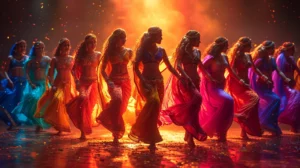
Amid the rhythms of life and the cadence of tradition, there’s a dance—more than just an exuberant series of steps. It’s a metaphor for the cultural continuum, a circle that reaffirms our humanity’s rich tapestry. In this post, we peel back the layers of one such dance, the Garba from Gujarat – a vibrant swirl of joy and energy, recently celebrated as part of UNESCO’s Intangible Cultural Heritage of Humanity, to explore the deeper connection between movement, memory, and the human spirit.
The Garland of Garba
The story of Garba is more than folklore; it’s a living, breathing mosaic that adorns the celebratory spirit of Gujarat throughout the Navratri festival. Deeper than the music that enlivens the air, richer than the kaleidoscope of colors that twirl under the dusk’s fading light, Garba connects generations through a symbolic dance that represents the divine feminine and the cycle of life.
Mirrors, Myths, and Memories
Each garment, a tapestry woven with ancient motifs, and mirrored with the reflection of the story. For those gazing from the outside, the mirrors carry the eye through a dizzying, delightful panorama. But for those within the circle, they reflect more than just light; they echo the unseen, the past adventurers, the forgotten tales that continue to shape the present and guide the future.
The Symphony of Inclusion
Music is the thread that binds the community, instruments resonating with cultural vibrations that urge the dancers to sway. The nuances of the Bhangra, the purity of the dholak’s beat, and the lyrical expanse that stretches across the night sky sings not only of the divine but also the rootedness of humanity to its core.
Steps That Speak
The intricate steps in Garba hold a whispered history, an oral tradition that only those who dare to dance in the circle learn. It is not just a matter of moving to the beat; it’s an echoing of ancient wisdom, a communal emphasis that fosters unity and strength. These steps offer an allegory for the delicate dance of life itself.
The Weaving of a Nation
In Gujarat, the festival of Navratri and the dance of Garba transcend mere celebration. It’s a time where the spirit of India’s femininity blooms, celebrated in syncopation and synchrony, in clockwise and anti-clockwise spins that echo the universe’s eternal dance. Garba is the weaver, and the people are the subjects, threads, and the fabric, the rich tapestry of Indian culture.
A Legacy in Motion
UNESCO’s recognition marks not just an achievement, but a call to action, an acknowledgment of the responsibility to safeguard, cherish, and pass on our most intimate cultural legacies. For those within the circle, it’s an affirmation that their identity, their dance, their devotion is not just theirs but belongs to all humanity.
Preserving Precious Heritage
The inclusion of Garba in UNESCO’s list is a reminder, a note of caution, a beacon to all who witness its beauty. It calls for a collective effort, transcending borders, thwarting time, to protect and promote the festivals and dances that define and refine our collective identity.
The Dance within Us
The true enchantment of Garba lies not only in its outward spectacle but in the echo it leaves within each of us. It resonates with our own quest for identity, celebration, and unity. Within every staggering step, every collective whirl, there is a metaphor for the dance of life, where we all participate, where we all have a part.
In the heart of every celebration, there’s a dance that captures the soul of a people. Garba has transcended its cultural cradle and now finds itself on the world stage, a cultural beacon shedding light on the universal stories that dance can tell. With the twirl of a sari and the sway of humanity in the circle, the unseen but deeply felt power of dance to unite a community, express a heritage, and share humanity’s essence is a treasure we must protect not only for the future of one dance but for the future of our shared humanity
Leave a Reply Cancel reply